September 2014
By Lyndsay Harshman
Travel Ethiopia picked us up at the airport in Addis Ababa (most nationalities can get the US$20 visa easily on arrival – lines are long and it can be a slow process) and headed to Bahir Dar and the Avanti Hotel on Lake Tana. The Bahir Dar area has a resort-feel with a sea wall along the lake and a palm tree-lined main road. Cafes line the streets and in warm weather locals sit and enjoy coffee under Christmas lights. It’s a very relaxed town and has a nice feel, it’s also extremely clean. Bahir Dar is the base for exploring the island monasteries, visiting the Blue Nile Falls and seeing the source of the Blur Nile in Lake Tana.
While we didn’t visit the monasteries on this trip, I have previously and they are an excellent introduction for setting the stage of the history of the Ethiopian Orthodox Church and the country as a whole. It’s definitely worthwhile, and I personally think Bahir Dar is a very comfortable first stop and the drive to Gondar from here is relatively short (2.5 – 3 hrs on a paved road) and quite scenic.
The Avanti Hotel is a larger resort-style hotel (approx. 135 rooms on the lake-front, do not confuse this with the Blue Nile Hotel in town) that is located on the shores of Lake Tana. Many rooms (please request a lake-front with Travel Ethiopia) overlook the lake and offer private balconies. While the rooms are a bit small, they do offer all of the amenities expected – hot showers, in-room safe, A/C (a requirement in Bahir Dar as it can get quite hot), TV, hair dryer and mini-bar. The rooms were very clean, white linens and duvets and the pillows and beds were comfortable. The bar serves a full bar menu and offers all of the local beers and the *new* Rift Valley wine label, a very drinkable wine produced by a French company in the Ethiopian Rift Valley near Lake Langano. The formal restaurant offers Ethiopian specialties, Italian specialties and fresh fish and burgers. The executive chef is Italian. The food was excellent and the breakfast was one of the most impressive buffets I’ve seen! While the hotel is bigger and doesn’t really have a particularly “Ethiopian” feel, the service was very friendly, food was good and the setting is lovely. For the price, I would definitely recommend it for a comfortable and “easy” first night outside of Addis.
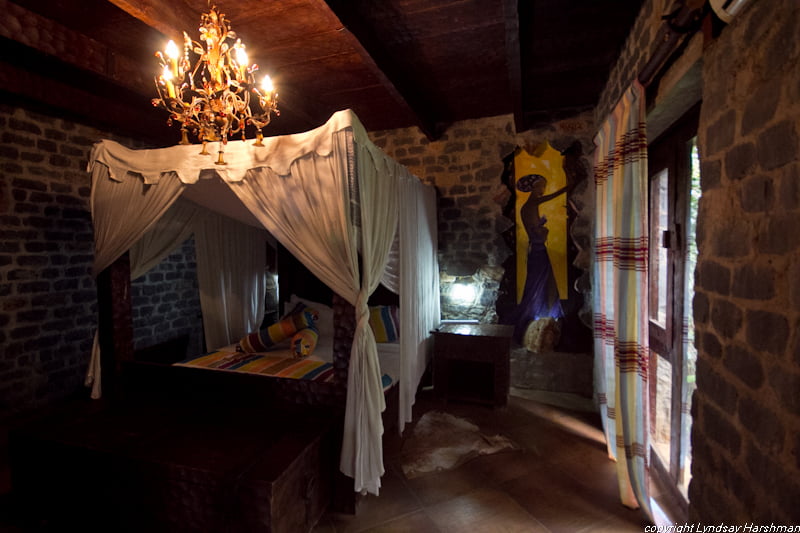
Now, for those travelers looking for more “authentic” accommodations and who are willing to spend more money, the Kuriftu Resort and Spa offers something unique. The two-story stone units (28 suites) surround lush gardens, an expansive pool and face the lake (I wouldn’t call the suites lake view, however). The suites are one-story, so two to a unit and offer verandahs or private balconies with sitting areas and fireplaces. Inside, rooms feature fireplaces, sitting areas and canopied beds (mosquito nets, Bahir Dar is a malarial area). En suite bathrooms have walk-in showers – some with tubs – and large sink basins. The feeling is very Ethiopian, with local stone walls, wood and leather furniture and local art and textiles. The rooms are quite dark, however, with all of the stone and could feel dank during the rainy season. The resort bills themselves as 5-star, but please bear in mind that the property is quite esoteric and feels rather bohemian. I really enjoyed the feel and look, but this isn’t Singita or even a Serena. The property itself is really beautiful and care has been taken in the design. The spa is quite exceptional, with private treatment rooms, manicure/pedicure room and a full tea and coffee/relaxation area. Honeymooners looking for a beautiful setting, all-inclusive amenities (complimentary spa treatments are included) and a very private experience would likely enjoy the hotel. The Presidential Suites offer in-room bars and dining areas and are really quite opulent, but once again a bit dark. The massive patio overlooking the lake is a great setting for sundowners and the restaurant has a nice atmosphere. Dinner is served buffet. There was quite a mix of international travelers, Ethiopians visiting from Addis and Ethiopians living over-seas, so it had a nice international feel to it.
From Bahir Dar we departed early for Gondar. The road to Gondar is nicely paved and passes through many small towns, through farmland and over a mountain pass. It’s quite scenic and an easy drive – I recommend it. Clients can depart after breakfast and arrive in Gondar for lunch before an afternoon historical tour.
Being an exploratory trip, we reached Gondar for lunch and continued on to the Simien Mountains another 2.5 hrs. We did lunch in Gondar at the Four Sisters Ethiopia Restaurant. The restaurant is tucked away behind the library and an old neighborhood across from an empty lot…very African. Once you step inside, the atmosphere is completely different. Lush gardens, beautiful art and a variety of seating areas and alcoves abound. The four sisters who run the restaurant are gracious and quite proud of their little gem. As they should be. The Ethiopian food was excellent (I had the vegetarian fasting menu) and the lentil soup starter was out-of-this-world. Hygiene and attention to detail were top-notch – the circled at meal time with the traditional hot water and basin for washing hands, but also provided hand sanitizer on the tables! The spot was a prefect break and this is a setting that most travelers would be willing to experience local food in (clean, comfortable and with guide books’ and TripAdvisors’ stamp of approval…for what that means!). There was a mixed crowd of Ethiopians and farenji so it didn’t feel like a tourist trap.
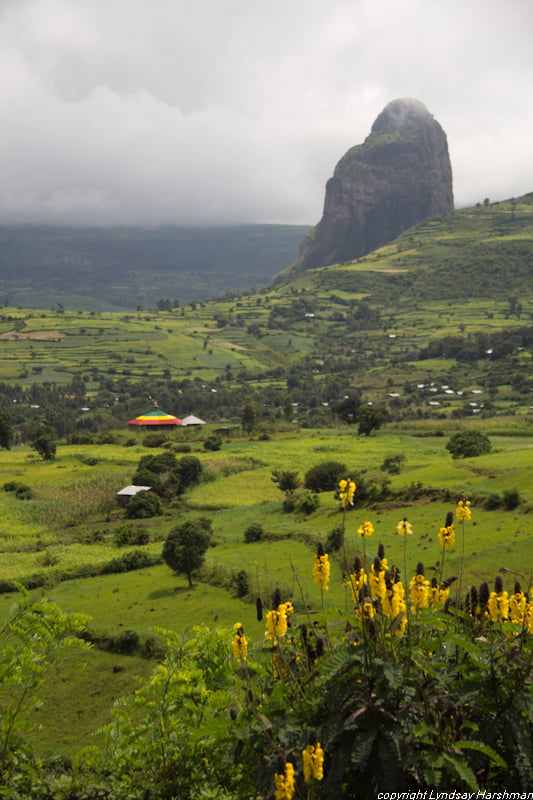
We continued through Gondar (and made a plan to return to the Dashen brewery and beer gardens on our way back) and on to the Simien Mountains. The road is paved now until the last 22kms, which are through a densely populated area and then high rangelands and into the park. The road is 4×4 and dirt, but was manageable even in the rainy season. The fog was a bit alarming, but the Travel Ethiopia driver was superb and our Toyota Land Cruiser did just fine on the steep, muddy roads. We arrived at the Simien Lodge before dusk, but the lodge was so socked-in with fog that I couldn’t see my hand in front of my face. The generator wasn’t on yet, so we dumped our bags in the room, layered on our warm clothes and did what any good traveler would do to stay warm: headed to the bar. Now this isn’t just any bar – it’s touted as the “Highest Bar in Africa” at 10,696 ft (3260m). A huge stone fireplace anchors the room and ample couches and cushy chairs surround the fire pit. Drinks aren’t cheap here, and they do charge a corkage fee, but bear in mind that this lodge is incredibly remote and everything is brought in by 4×4. For a night or two, it’s worth the splurge. The night was cold and damp and we were a motley crew with woolen hats, mittens and layers upon layers, but we entertained ourselves by the fire until dinner. The meal was a simple affair, but given the nearly full house that night, the wait staff did well and the food came out hot and quickly. It wasn’t gourmet by any means, but hot comfort food at 10,000 feet does the trick. There is a small curio shop open in the evenings with locally produced crafts – prices are high, but the quality was fair and assuming they were produced in the nearby villages it’s not a bad gig to support.
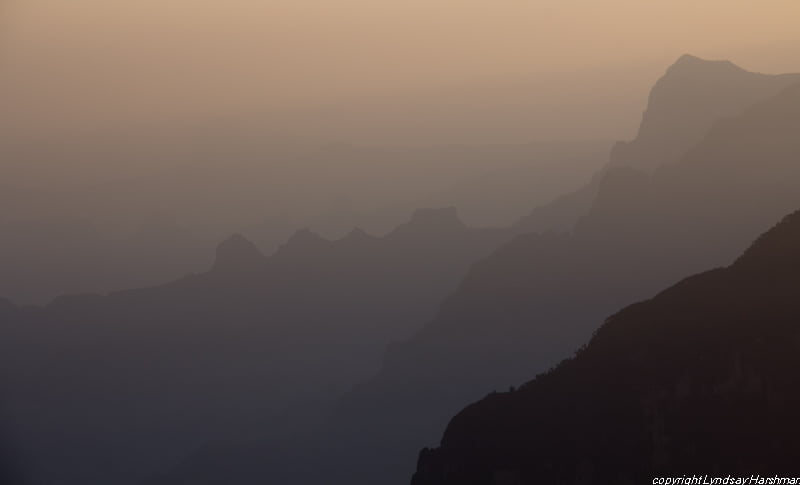
The generator eventually came on, but the rooms were still quite dark and the solar power was weak in the rainy season months. The room was cold, damp and dark. It was, in fact, too cold to shower, so I climbed in bed with socks on and my hot water bottle (good thinking on the lodge’s part). The bed was comfortable and the rooms were clean. The rooms, sadly, don’t have the view I anticipated, but the lodge provides easy access to hiking, the gelada baboons and incredible mountains vistas so it is absolutely worth a nights’ stay or two (if your pax are keen to do multi-day trekking Travel Ethiopia offers multi-day trekking trips, with full top-end kit, kitchen staff, meals and guides).
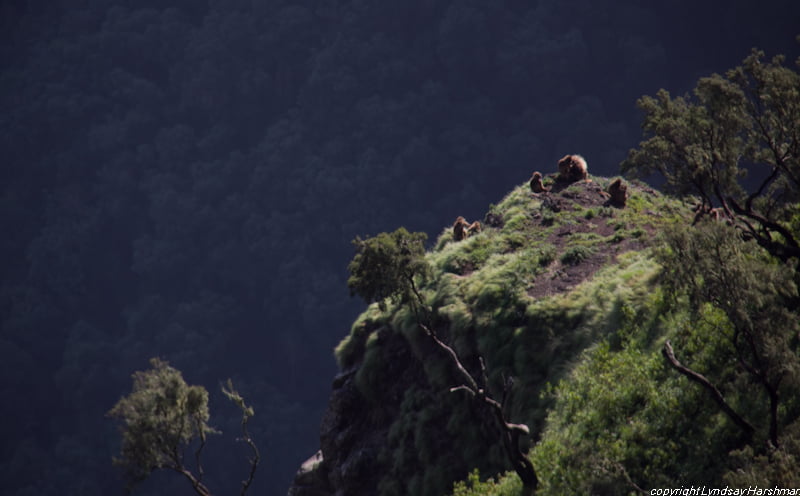
The sunrise the next morning was incredible, the mountains’ shadows created layers in the glowing mist and the thin air made me wake up awfully fast pre-coffee. It really is a special place: the scenery is other-worldly, the endemic wildlife is exceptional (read: primate experience without crowds, permits, regulations to note nor physically taxing – but beware the altitude is noticeable!). After breakfast and coffee we headed out on a morning hike. I wasn’t expecting the scenery that we encountered on a short 2.5 hour jaunt from the lodge. Let’s close our eyes for a moment and imagine a setting not unlike that of Middle Earth or the home of Bilbo Baggins with soaring peaks, long grasses, and crooked trees laced with moss. The shades of green made me blink they were so saturated. St. John’s Wort, giant Heather, endemic grasses and the vibrant blankets of Meskel daisies. All of this, then it suddenly tumbles off the edge of a rocky precipice, farmland thousands of feet below. Now add the bearded vulture (with a 2+m wingspan) soaring overhead and the endemic Gelada baboon gather around. It’s pretty cool.
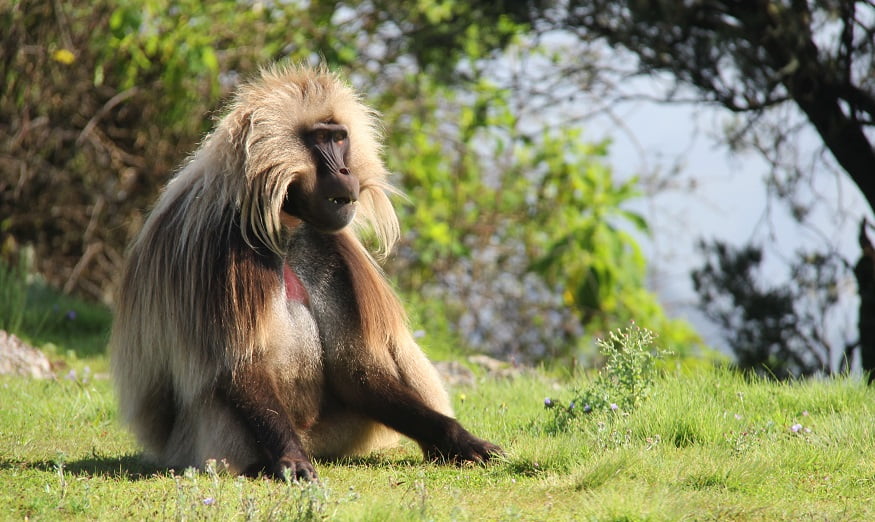
Now about the baboons. We left earlier than the others (7:30 am) for our hike and it paid off. We had nearly an hour alone with the baboons. The time isn’t monitored and the park staff is generally very relaxed about the viewing as long as travelers are quiet, respectful and remain a couple of meters away from the primates. The baboons are more closely related to monkeys, and they are fascinating to watch. Their blond locks look as if they met a 1980s hairstylist, fully crimped into an enviable mane. They are incredibly relaxed and really paid no attention to us, only occasionally glancing up for a photo op. It was priceless.
For most North American travelers on a tighter timeline, one night in the Simien Mountains would be manageable. If clients spent the previous night in Gondar and arrived in the early afternoon at the Simien Lodge, they could do an activity that day. Overnight and the next morning a hike and baboon watching would be in order. Returning to Gondar after lunch would be easy and comfortable. If clients want to trek, a specialized trekking itinerary will be proposed. Travel Ethiopia offers full trekking kit (a high-end European brand with dome tents, 4 inch bed rolls, linens, flash-light, water basin and dining area with private chef) and trekking guides, as well as local park guides. It is possible, for those who are keen, to hike from the Simien Mountains all the way to Axum. Anyone want to join me? Ha.

After our hike we drove back to Gondar in time for lunch at the Quara Hotel overlooking the center square of town. The pizza wasn’t half bad and the minestrone soup took the edge off the still chilled bones in my body. We spent the afternoon touring the Royal Enclosure, Debre Birhan Selassie Church and the Fasilides Bath. Our guide was the former director of the historical parks in Gondar and his wealth of information was impressive, to say the least. First off, the Debre Birhan Selassie church is one of the last remaining churches that was built in the 17th century and wasn’t destroyed by invaders from Sudan in 1888. The paintings tell the story of Bible and incorporate Ethiopian religious folk lore and saints. The ceiling is quite memorable with the faces of hundreds of Ethiopian cherubs staring down from heaven with faces of either surprise or sadness as they watch the deeds of humanity unfold. Even a short visit to the church is enlightening. The Royal Enclosure and the Baths are one of the sleeper-hits in Ethiopia for me. I love Gondar Castlethe surprising, well-intact architecture, the clearly advanced design during a time when mud huts ruled in nearby nations, the lore and stories behind the structures. Plus, Gondar is just an interesting city. We explored, one-by-one the castles in the Royal Enclosure, the healing sauna – quite impressive – and the lions’ cages, before continuing to the Fasilides Bath. The Bath is an impressive structure that is still used during the Timkat holiday in January when the bath is filled, slowly over several weeks’ time from the local river, then used as a massive bath for the dedicated followers of the church and tourists alike. I haven’t seen it personally, but I’ve heard it’s quite the sight to behold. During the shoulder season, the site is quiet and the light filters through the trees and into the empty bath. It’s extremely peaceful and the prefect way to end the historical tour in Gondar. The best way to end the day of touring is at Gondar’s Dashen Brewery and Beer Garten. The Germans set up the Dashen brewery and it meets the Reinheitsgebot: the beer is slightly hoppy and fresh. We visited the garten on New Year’s Day (now remember that Ethiopia is on the Julian Calendar and is seven years behind us. New Year’s Day this September 11 was for the year 2007!) and there was a proper party going on – live music and all of the local kids out dancing and drinking. It was fun and a good adventure. On any other day of the year, travelers can grab one of the pine picnic tables in the garten and enjoy a lager from the tap. It’s worth a visit if your clients are interested in beer and its world-wide culture.
From Dashen we continued to the Mayleko Lodge outside of town near the airport. The location is ideal for the morning flights out of Gondar and the new lodge-style hotel shows a lot of promise. The rooms are very spacious, extremely clean (tiled floors, white duvets and linens) and offer locally produced furniture and art. Some rooms are white-washed walls and others are stone. The bathrooms are en suite and offer a sink basin, toilet and walk-in shower with rain-style shower head and a hand-held shower. Note: There is a small switch in the bathroom that must be turned on for the hot water to heat). Dinner was a bit taxing with pleasant service, but the meal was prepared very much from scratch and serving only our group took over an hour. All this said, the manager was extremely helpful and the setting is lovely. The rooms themselves were some of the best of the trip. Watch this space as I’m sure it will improve as they gain experience – it only opened in the last few months.
Stay tuned for Part 2: Lalibela, Lake Langano, The Bale Mountains and Addis
**Please note that we are preparing a hotel summary with photos from the Ethiopia exploratory trip, please stay tuned. For more information on this report please contact the Kusini Collection or Travel Ethiopia.
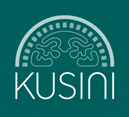


Leave A Comment
You must be logged in to post a comment.